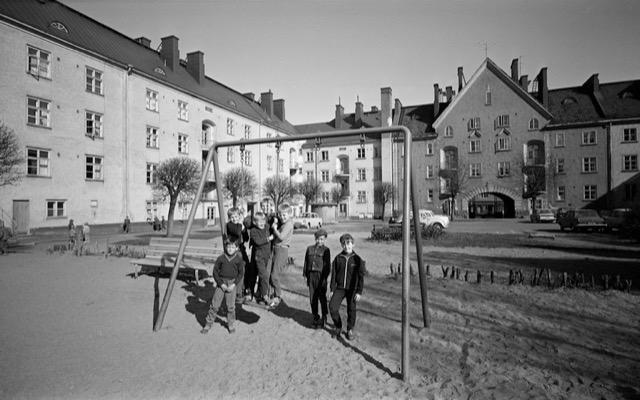Nordic countries
Coordinators:
Johan Mårtelius (KTH Royal Institute of Technology, Stockholm – Sweden)
Antonello Alici (Polytechnic University of Marche, Ancona - Italy)
Chiara Monterumisi (EPFL - École Polytechnique Fédérale de Lausanne – Switzerland)
Research team:
Alvaro Clua Uceda (Universitat Politècnica de Catalunya – Spain)
Abdellah Abarkan (Blekinge Institute of Technology, Karlskrona – Sweden)
Monica Andersson (Stockholm University – Sweden)
Giovanni Bellucci (Polytechnic University of Marche, Ancona – Italy)
Elin Børrud (Norwegian University of Life Sciences – Norway)
Claes Caldenby (Chalmers University of Technology, Gothenburg - Sweden)
Mina Di Marino (Norwegian University of Life Sciences – Norway)
Karl Otto Ellefsen (AHO Oslo – Norway)
Jaime Ferrer Forés (Universitat Politècnica de Catalunya – Spain)
Kjell Forshed (Brunnberg & Forshed architects, Stockholm – Sweden)
Pekka Heikkinen (Aalto University – Finland)
Anu Koponen (Independent researcher and architect – Finland)
Dag Kittang (Norwegian University of Science and Technology, Trondheim – Norway)
Laura Kolbe (Helsinki University – Finland)
David Kuchenbuch (Justus-Liebig-Universität Gießen – Germany)
Markus Löhteenmäki (ETH Zürich – Switzerland)
Sofia Nannini (Polytechnic University of Turin – Italy)
Riitta Nikula (Helsinki University – Finland)
Aino Niskanen (Aalto University, Helsinki – Finland)
Catharina Nolin (Stockholm University – Sweden)
Simo Paavilainen (Aalto University – Finland)
Martin Søberg (Royal Danish Academy, Copenhagen – Denmark)
Anne Tietjen (University of Copenhagen – Denmark)

A Nordic node, comprising also the Baltic countries, seems to be of great interest in as much as it could identify and promote a common ground and approach to past and contemporary issues of urban design.
In this context, research will address:
- contemporary policies for the densification of traditional perimeter block housing and garden cities schemes;
- regional and local urban design traditions with regards to inherited forms and aesthetic principles, the environmental and architectural quality of garden cities, as well as the wooden architecture that affected the scale and intimacy of projects’ arrangements before cities’ modernization;
- planning initiatives promoted in pre- and post-war years (and focused on housing and/or civic centers) for reshaping the cities, in relation to identity issues and socio-political transformations.
The research will be developed in comparative terms, identifying the role of conceptual evolution and of prominent figures.
A subtheme of the Nordic node will be developed around the North-South interrelations, focusing on the role and impact of north-south connections to urban design. The fields of investigation will regard cultural exchanges between Nordic and Mediterranean countries since late 19th century, promoted through field trips, visits, educational programs of relevant institutes, planning and infrastructural projects.
The research of both themes will utilize as primary sources journals, planning exhibitions, conferences, etc.
Seminar cycles will be developed around these topics.
Seminar cycle
Affordable Social Housing 1910s-1930s. A comparative study

scientific promoter: Aino Niskanen
coordinators: Antonello Alici, Chiara Monterumisi, Johan Mårtelius
The first cycle of seminars deals with working class and/or low-income neighbourhood areas of the interwar period and their impact on part of the cities. The focus is also more in general the city, spanning from the smaller scale of the dwelling units to the larger scale of the communal areas. As starting point for the comparative study, the Nordic interventions of the period play a central role for the present series of research seminars – because these are still little known outside the borders. But the goal is to widen the analysis via the inclusion of coeval cases study designed in other countries in order to portray a larger and more solid overview of housing policies. The comparative look aims to draw on the specificities and common aspects among the different policies and housing estates.
The main possible questions to address are:
– why these were successful as housing areas?
– where the influences and references came from? how much international exchange was there?
– how were housing typology developed in the different examples?
– how were the inhabitants selected? how did they finance their housing?
– which was the role of the state and/or community involved in the planning? which were the specificities of each country regarding housing-planning policies?
– what is their legacy and to which extent can we learn from them?
Other interesting aspects that can be discussed are:
– how much interest did they raise in local and foreign professional journal, in newspapers and exhibitions at that time and later?
– what is their state of conservation today?
The present series of seminars encourage different methodologies like historical and research by design, bearing in mind how the formulation of affordable social housing policies in the 1910s-1930s encompassed multifaceted domain of knowledges and expertise.
23 March 2022
Antonello Alici (Polytechnic University of Marche, Ancona – Italy)
opening address
Aino Niskanen (Professor Emerita, Aalto University – Finland)
introduction
-
Claes Caldenby (Professor Emeritus, Chalmers Arkitektur Göteborg – Sweden) Gothenburg’s governor’s houses: A unique, exceptionally widespread and highly appropriate housing type
-
Anu Kaisa Koponen (Architect, PhD, Institutum Romanum Finlandiae – Italy) Tradition and Innovation in Social Housing Projects by Innocenzo Sabbatini
-
Chiara Monterumisi (Post Doc Fellow, University of Bologna, PhD, Architect – Italy) Rödabergsområdet in Stockohlm: a verdant small town idyll within the city
25 May 2022
Aino Niskanen (Professor Emerita, Aalto University – Finland)
opening address
Johan Mårtelius (KTH Royal Institute of Technology, Stockholm – Sweden)
introduction
-
Martin Søberg (Associate Professor, Royal Danish Academy, PhD, Architect – Denmark) Kay Fisker and Social Housing in Denmark c. 1920–1940
-
Aino Niskanen (Professor Emerita, Aalto University – Finland) Early co-operative housing in Helsinki and the birth of Käpylä neighbourhood
-
Simo Paavilainen (Professor Emeritus, Aalto University – Finland) Wooden Käpylä – townplan and architecture, apartments and inhabitants, the role of community and legacy
-
Monica Andersson (Chairman of Samfundet S:t Erik, Senior lecturer in Political Science, Stockholm University – Sweden) Hallman in Stockholm – Garden City Movement in Artistic Town-Planning for working Class Families
-
Pekka Heikkinen (Professor Aalto University – Finland) Innovative and sensitive with scarce resources – is it even possible
-
Marcus Lähteenmäki (PhD art historian, ETH Zurich – Switzerland) Leningrad: New Landscapes 1917–1932


